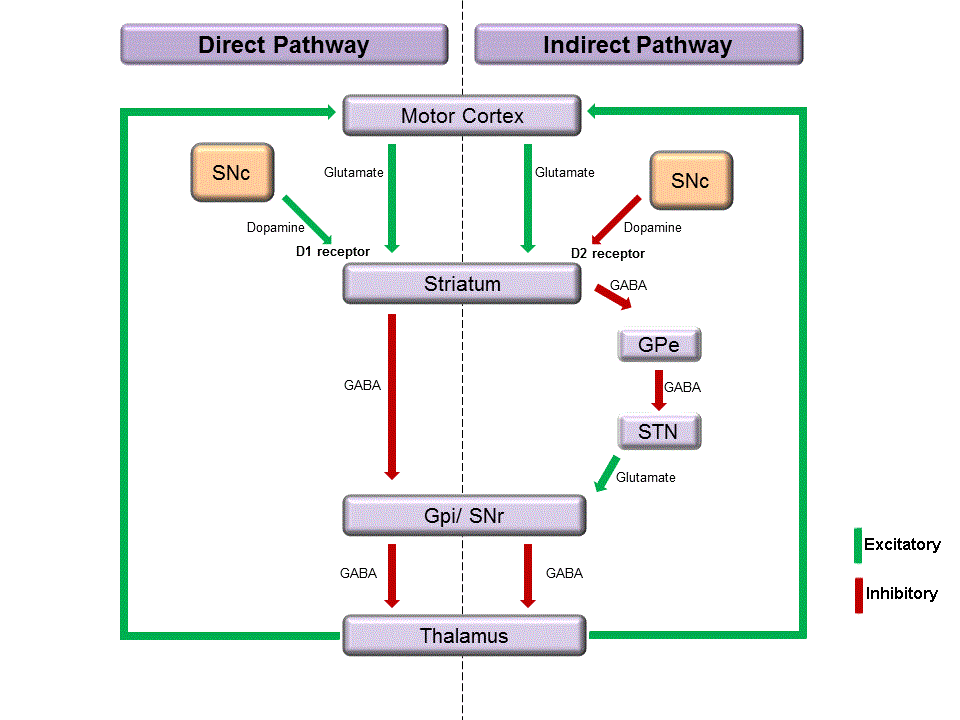WBR0590
Jump to navigation
Jump to search
| Author | [[PageAuthor::Rim Halaby, M.D. [1] (Reviewed by Yazan Daaboul, M.D.)]] |
|---|---|
| Exam Type | ExamType::USMLE Step 1 |
| Main Category | MainCategory::Anatomy, MainCategory::Physiology |
| Sub Category | SubCategory::Neurology |
| Prompt | [[Prompt::Deep brain stimulation (DBS) is an invasive therapeutic procedure indicated for advanced Parkinson's disease. It consists of the surgical implantation of a device that sends high frequency electrical impulses into areas of the basal ganglia, particularly the subthalamic nucleus (STN) and the globus pallidus internus (GPi). It is hypothesized that the mechanism by which DBS improves parkinsonism symptoms includes hyperpolarization in the STN by DBS, which results in a reduction in the subthalamic excitability. Which of the following changes in neurotransmitter release is the result of the reduction in subthalamic excitability?]] |
| Answer A | AnswerA::Reduction in glutamate release from the STN and GABA release from the GPi |
| Answer A Explanation | [[AnswerAExp::The inhibition of the STN results in a reduction in glutamate release, which leads to reduced stimulation of the GPi and a reduction in GABA release.]] |
| Answer B | AnswerB::Reduction in glutamate release from the STN and increase in GABA release from the GPi |
| Answer B Explanation | AnswerBExp::GABA release from the GPi is reduced following the reduction in subthalamic excitability. |
| Answer C | AnswerC::Increase in glutamate release from the STN and increase in GABA release from GPi |
| Answer C Explanation | AnswerCExp::Release of both glutamate is reduced following the reduction in subthalamic excitability. Consequently, the GPi stimulation is reduced, which results in a reduced concentration of GABA. |
| Answer D | AnswerD::Increase in glutamate release from the STN and reduction in GABA release from the GPi |
| Answer D Explanation | AnswerDExp::Glutamate release is reduced following the reduction in subthalamic excitability. |
| Answer E | AnswerE::Reduction in glutamate release from the STN with no change in GABA release from the GPi |
| Answer E Explanation | AnswerEExp::GABA release is reduced following the reduction in subthalamic excitability. |
| Right Answer | RightAnswer::A |
| Explanation | [[Explanation::Activation of the indirect pathway of the basal ganglia begins and ends with the motor cortex to invoke excitatory stimuli to the peripheral muscles. Initially, the motor cortex stimulates the striatum (caudate and putamen) via glutamate release. The activated striatum in turn releases GABA (universal inhibitory effect), which has receptors at the level of the globus pallidus externus (GPe). As the stimulation of the GPe is reduced, the subthalamic (STN) stimulation is also reduced. This reduction results in a decrease in glutamate release from the STN, which in turn reduces the release of GABA from the globus pallidus internus (GPi). As the concentration of GABA from the GPi decreases, the inhibition of the motor cortex, which was initially present, is lost. With the reduction in the concentration of GABA, the motor cortex is then able to fire excitatory stimuli to the peripheral muscles and invoke muscular movement. Shown below is an illustration that summarizes the direct and indirect pathways of the basal ganglia.
|
| Approved | Approved::Yes |
| Keyword | WBRKeyword::Basal ganglia, WBRKeyword::STN, WBRKeyword::Neurotransmitter, WBRKeyword::GABA, WBRKeyword::Glutamate, WBRKeyword::Subthalamic nucleus, WBRKeyword::Globus pallidus internus, WBRKeyword::GPi, WBRKeyword::Motor cortex |
| Linked Question | Linked:: |
| Order in Linked Questions | LinkedOrder:: |
